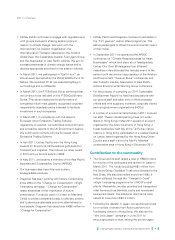Cathay Pacific 2011 Annual Report Download - page 21
Download and view the complete annual report
Please find page 21 of the 2011 Cathay Pacific annual report below. You can navigate through the pages in the report by either clicking on the pages listed below, or by using the keyword search tool below to find specific information within the annual report.
Cathay Pacific Airways Limited Annual Report 2011 19
Europe
Revenue from European routes generally increased
more than capacity in 2011. Premium class business
was generally stronger than economy class business.
Numbers of passengers carried and yields increased at
a slower rate as the year progressed.
The performance of the London route was robust in
2011. Revenue grew despite there being little change
in capacity. Yields improved, particularly in the
premium classes.
The Milan route has performed consistently well since
it was launched in 2010. In July 2011 we increased the
number of flights on the route from four per week
to daily.
We put extra capacity on the Paris route from March to
October 2011.
The Moscow route continued to suffer from intense
competition. Load factors decreased in 2011.
North Asia
Business derived from Mainland China continued to
increase in importance in 2011. Revenue growth
benefited from strong demand for premium class
travel. Demand for travel on routes to secondary cities
was strong. Dragonair increased its capacity on a
number of routes accordingly. The Shanghai route was
relatively weak, with competition on the route
increasing.
The increase in cross-strait flights to and from
Mainland China continued to affect our business on the
Taiwan routes. However, the effect of this was
partially offset by growth in the number of passengers
flying to and from Hong Kong in order to connect to
other routes, particularly in Europe. Revenue on the
routes grew in 2011, but at a diminishing rate towards
the end of the year.
Revenue from Korean routes grew more than capacity
in 2011, helped by strong demand for all class of travel.
However, competition for economy class business
increased, especially on the Busan route. This
adversely affected yields.
•
•
•
•
•
•
•
•
The earthquake and tsunami in March 2011 adversely
affected demand on our Japan routes and we reduced
capacity accordingly. Load factors fell, particularly to and
from Tokyo. Demand for travel from Japan recovered
more quickly than demand for travel to Japan. The
recovery in demand started in August 2011 and full
capacity was restored by the end of October.
North America
There was strong demand for all classes of travel on our
North American routes in 2011. Demand from corporate
customers travelling from the United States to
Southeast Asia was particularly strong. Economy class
yields fell as the year progressed.
We increased capacity on the United States routes in
2011. We added a fourth daily flight to New York in May
(this flight being our third daily non-stop service). We
launched a daily service to Chicago in September. These
two new services have increased the number of
premium class passengers carried. Economy class loads
on the Chicago route are below expectations.
We announced a number of new codeshare agreements
in North American. Our code was placed on Alaska
Airlines’ flights operating between Los Angeles and
both Mexico City and Guadalajara in Mexico in June;
and on American Airlines’ flights operating between
New York and both Sao Paulo and Rio de Janeiro in
Brazil in December. We also expanded our codeshare
agreement with American Airlines to cover 11 more
destinations in the United States, most of which are
connected via Chicago.
Load factors and demand for premium class travel on
the San Francisco and Los Angeles routes were
satisfactory in 2011.
In Canada, revenue grew as expected in 2011, but less
than capacity. We added two flights a week to Toronto
to make it a twice-daily service from May. Yields on the
Vancouver route, particularly in economy class, fell as a
result of increased competition.
We expanded our codeshare agreement with WestJet
in Canada by putting our code on their flight between
Vancouver and Kelowna. We now cover seven domestic
destinations under this agreement.
•
•
•
•
•
•
•
Review of Operations PASSENGER SERVICES
























